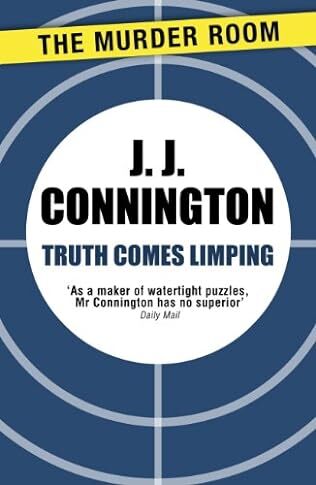Truth Comes Limping

A review of Truth Comes Limping by J J Connington – 240204
It is a while since I have read anything by J J Connington, the pen name of Alfred Stewart, a distinguished Chemistry professor in his day. Thirteen, they say, is lucky for some and unlucky for others and Truth Comes Limping, the thirteenth in his Sir Clinton Driffield series, is somewhat below the standard of some of his earlier novels. It is aptly titled as the resolution of the mystery takes a long, perhaps overly long, while to emerge. It is long-winded book, not helped by the prolix journalist, Bob Denzil, who speaks as if he is paid by the word.
Sir Clinton, the Chief Constable, is called to investigate the death of a stranger found in the undergrowth on Leisurely Lane bordering the Carfax estate. One of the first to come across the body is a picaresque poacher who is in the process of helping himself to the £100 the otherwise impecunious Miles Huggin was carrying about his person. Although Huggin was shot, there is no trace of a bullet or a weapon. During the course of the investigations, there are two more murders, of Druce Carfax, the landowner, and the gamekeeper, lured into the woods by a note from a WELLWISHER warning of an attempt to snaffle pheasants, even though it was out of season.
Sir Clinton is accompanied by his faithful Watson, Wendover “The Squire”, who is appalled that any suspicion of crime, let alone murder most foul, should fall on a prominent family of the local landed aristocracy. Wendover is at his most unsufferable worst, espousing deeply conservative views about the countryside, and failing to grasp even the basics of what is going on is the device that Connington uses to impress upon the reader the brilliance of the professional sleuth. However, even Sir Clifford fails to twig the importance of some of the information he uncovers, which if he had would have significantly shortened the story.
The book contained a couple of words which have gone to extend my vocabulary. Firstly, Denzil frequently, too frequently in my book, refers to Sir Clinton as alguazil. This, apparently, is a term for a an officer of the law in Spain and Latin America who had once held high rank and is now enjoying an inferior status, presumably intended to be a humorous jibe at the Chief Constable. More relevant to the story is Melchizedek, a character in the Old Testament, not my strong point, I am afraid, and a variant of whose name also appears in Dickens’ Bleak House, who has no genealogy. It is an apt reference as the whole nub of the story is who is the true heir to the Carfax estate as the previous owner was not averse to sowing his wild oats.
This becomes a tale of blackmail and a desperate attempt to, on the one side, suppress the truth and, on the other, to reclaim rights in accordance to an unusual provision in Griswold Carfax’s will. Some of the familiar tropes of crime fiction are wheeled out – a character with a dual identity, much ado about the typeface of a typewriter and a mildly ingenious plan to remove it from the scene. Toxophily, archery to you and me, figures prominently and is the explanation for how the first murder was committed. A longbow and an extensive quiver full of arrows also provides the drama as the net closes around the culprit, although Connington cleverly springs a little surprise which in part rescues the book.
As always Connington plays fair with his reader and has devised a clever and compelling plot which, ignoring all the background persiflage, is interesting enough, but, for me, there was not the spark that there was in some of the earlier and far better books. The curse of thirteen, indeed.



